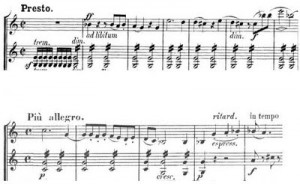 Music Mind Games by Michiko Yurko is the most enjoyable and profitable thing we have used in studying music theory. The first time I used this book was with a classroom of three year olds. I was able to teach them many basics of music theory through engaging games. We all had fun and I was amazed at what they were able to learn. In just a few short months the three year olds had learned many difficult rhythm patterns, which they could clap or say. One child could build a long rhythm string and another could tap it out on a drum. It was astounding. They also learned the names of all the musical notes in ascending and descending order, and several other theory concepts.
Music Mind Games by Michiko Yurko is the most enjoyable and profitable thing we have used in studying music theory. The first time I used this book was with a classroom of three year olds. I was able to teach them many basics of music theory through engaging games. We all had fun and I was amazed at what they were able to learn. In just a few short months the three year olds had learned many difficult rhythm patterns, which they could clap or say. One child could build a long rhythm string and another could tap it out on a drum. It was astounding. They also learned the names of all the musical notes in ascending and descending order, and several other theory concepts.
The children’s favorite game was Yurko’s Blue Jello card game. She prints note stems onto cards and assigns a silly name to each rhythm (such as Blue for the quarter note and Jello for the eighth note). The children can build–and read–complicated rhythms as they learn the names for the different stems.
Here is a video of her working (playing!) with a two year old.
The child is learning how to read rhythm and loving it. There are many videos on this site which will give you an idea of how to do some of her games on your own. Try to find the ones in English!
There are tons of games in this thick book. Many can be done with very young children, and many are of value even to older, more advanced students. I took piano lessons for 12 years but only began to understand some music theory concepts after working with this book. I have not used this book for a few years with my children, as music theory is pretty low on our priority list at the moment! But if you need music theory, you can’t go wrong with these materials. They are truly excellent. Here is another link to this book on Amazon, if you want to read more reviews and “see inside”.
Before you order it, one caveat: many of the games require supplies which do not come with the book. You can purchase many of the supplies needed as a set, called the Puppy Packet, but it is not cheap.
Each item in the Puppy Pack can be purchased individually, and by clicking on the individual links you can easily see how you might make your own Music Alphabet Cards and Tempo Cards and other needed supplies for use in the games. There is also a Magic Staff pack available for sale.
I used the book for a long time before buying any additional supplies. I was able to make supplies for many of the games myself using markers and index cards. The Blue jello word cards can be downloaded and printed quite inexpensively, as well. Click here to view a sample. Many other supplies cannot be purchased as they are out of print, but this game book is still more-than-worth the purchase price for anyone who is serious about having fun while teaching music theory to a child.

Molly,
Thanks for your informative post on music theory! I found two other resources for music theory games. The first is also by Michiko Yurko: Musopoly. Musopoly is a board game, but the manipulatives that come with the game are many of the same ones that are needed in Music Mind Games – for a lot less money.
The second resource is OOP: Keyboard Capers by Rebecca Doyle Stout. The games are very, very similar to those in Music Mind Games. Reproducible masters are included in the book. At the time I bought my book, I was also able to get a kit with all the cards, laminated and ready to be cut out. Keyboard Capers may now be published under the title Previews, Volume 1, but I am not sure.
I think I’m going to get some games ready to play for next week.
Susan in La